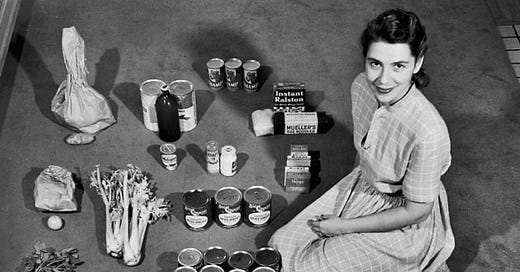Was $12.50 in 1947 Really Better Than $357.38 Today?
Surprisingly, things can become both more expensive and more affordable at the same time.

A photo intended to illustrate how expensive things have gotten since 1947 is making the rounds on the internet that is intended to illustrate how expensive things have gotten since 1947. The caption reads “Housewife in 1947 poses with a week’s worth of groceries, which cost her just $12.50. With this budget, she managed to feed herself, her husband, their four-year-old twins, and even the family cat. ”
Surprisingly, things can become both more expensive and more affordable at the same time. While monetary inflation has clearly made the prices of many things higher, it’s also increased wages. Provided wages are increasing faster than prices, the time price will be decreasing, and the time price is the true price we pay.
In 1947 blue-collar workers were earning $1.30 an hour in wages and benefits. This means it would take 9.62 hours of work to buy these groceries. Today’s blue-collar workers are earning $37.15 an hour, so working 9.62 hours would give them $357.38 to buy a week's worth of groceries.
Note that there were no Walmarts in 1947. Sam Walton’s first store was Walton’s 5 & 10, opened in Bentonville, Arkansas in 1950. His first Walmart store was opened on July 2, 1962, in Rogers, Arkansas. A typical Walmart Supercenter carries around 120,000 different items, though this number can vary depending on the store size and location. Walmart's online marketplace offers significantly more products, with estimates reaching up to 100 million items available. You can also order online and have your groceries delivered today as fast as one hour. No such options existed in 1947.
There was no year-around access to fresh fruits and vegetables in 1947. Malcom McLean’s innovation of shipping containerization in 1957 made it possible for us buy affordable fresh grapes in January.
Americans spend about 11.2 percent of their disposable income on food, based on the latest data from 2023. This figure reflects spending on both food at home (like groceries) and food away from home (like restaurants). Back in 1947, the share was much higher—around 23 percent of disposable income went to food, primarily for groceries since dining out was much less common.
Key Question: Would you rather have $12.50 in 1947 or $357.38 today? Keep in mind the comparatively limited choices back in ‘47 before you decide.
Gale Pooley is a Senior Fellow at the Discovery Institute, an Adjunct Scholar at the Cato Institute, and a board member at Human Progress




Not only that, but the quality of the food she has is sub-par compared to today. I built off of one of your earlier essays on this topic and tied it into a larger fear of the future.
https://www.polymathicbeing.com/p/apocalypse-always
Note that $37.15 includes benefits. Wage data source: measuringworth.com. Used the same source for 1947. Also see Bureau of Labor Statistics and https://www.bls.gov/news.release/pdf/ecec.pdf and https://data.bls.gov/dataViewer/view/timeseries/CES0500000008
The blue-collar nominal rate has increased by 2,758 percent since 1947. The unskilled rate has increased by 2,670 percent. Wages have generally increased much faster than prices for almost all products. Except for products and services heavily influenced by government policy.